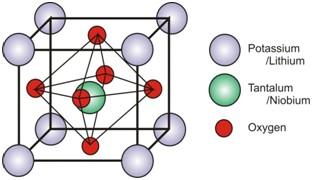KLTN Crystal
Potassium Lithium tantalate niobate (KLTN) is a ferroelectric crystal that was invented to be the optimal core medium in devices that employ the electrooptic effect at the paraelectric phase. The chemical composition of KLTN is given by: K1-yLiyTa1-xNbxO3. KTN is a derivative of potassium tantalate niobate (KTN).
The ferroelectric phase transition (Curie) temperature of KLTN is determined by the concentration ratios [Nb]/([Ta]+[Nb]) and [Li]/([K]+[Li]) (x and y respectively). For example for y=0: Tc [K] ≈682x+33.2 [REF1]. Above Tc, KLTN is an oxygen perovskite with cubic structure as illustrated schematically in Figure 1.
|
Figure 1: The structure of KLTN at the paraelectric phase |
Figure 2: Mn doped KLTN crystal |
At the paraelectric phase KLTN is centrosymmetric manifesting a quadratic electrooptic effect given by
Δn=(½)n03geff.ε2E2 (1)
where Δn is the electrically induced change in the refractive index, no is the refractive index at the paraelectric phase, geff. is the effective quadratic electrooptic effect, ε is the dielectric constant, and E is the applied electric field. Upon approaching Tc, the electrooptic effect becomes exceptionally large exhibiting Δn≈10-2 [REF2].
However, at the paraelectric phase, the Nb and Li ions emerge from the center of their respective sites and create nano-dipoles that hop at random between different directions. Upon approaching Tc, these dipoles interact and group into large dipolar clusters that fluctuate in space and time exhibiting the behavior of a glass forming liquid. In KTN, these clusters cause light that propagates in the crystal to scatter which renders KTN to be technologically useless.
Research that was done recently at the Hebrew University has shown that these showstoppers can be removed. It was shown that in KTN that was slightly doped with Li (KLTN) the exceptionally large EO effect was maintained, but the scattering was inhibited. A typical result is shown in Figure 3 in which the output intensity from an EO “crossed polarizers” (CP) modulator vs. the applied electric field is presented for KTN and KLTN.

(left) KTN at T=Tc+4ºC; (right) KTN:Li at T=4.4ºC.
As can be seen, the output beam polarization in the case of KTN is undefined, whereas the output in the case of KLTN remains with well defined polarization [REF4]. Similar to other electrooptic crystals (e.g. lithium niobate), KLTN always contains traces of impurities which cause it to generate optical damage when illuminated with light at short wavelengths. However, unlike other electrooptic crystals, in KLTN the formation of optical damage can be suppressed by operating electrooptical devices with a KLTN medium with bipolar voltage [REF5].
KLTN crystals that were intentionally doped during the growth exhibit a strong photorefractive effect. Due to the fact that the electrooptic effect is quadratic the photorefractive effect is “voltage controlled”. This make KLTN an optimal material for implementing electroholography [REF6].
Bulk KLTN crystals are grown by the Top Seeding Solution Growth Method [REF7]. Epitaxial thin films are currently drown by liquid phase epitaxial growth technique. Growth by metalorganic chemical vapor deposition is reported in the literature (U.S. Patent 5,581,396 (1996)).
A fabrication technique for constructing integrated photonic devices and circuits in KLTN based on the implantations of ions at high energies is described in: RI_Eng [REF8].
In summary, KLTN together with Na doped KTN (KNTN) which manifest similar behavior, are the optimal materials of choice in devices that are based on the PE EO effect.



